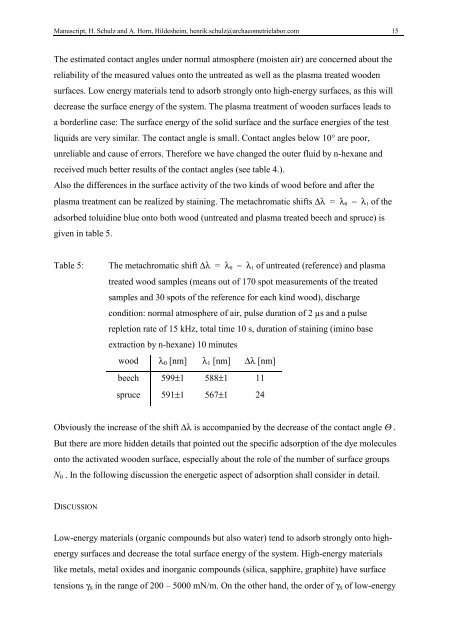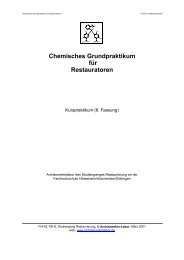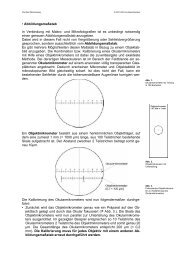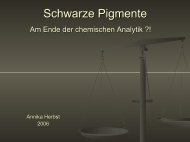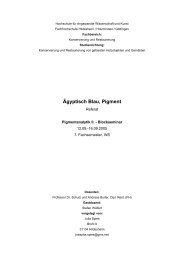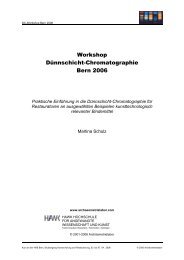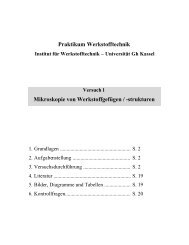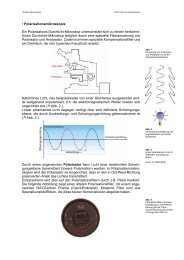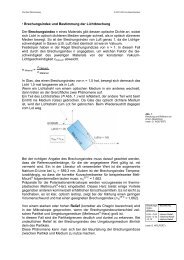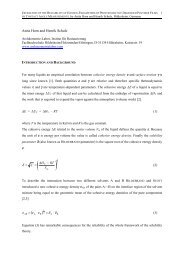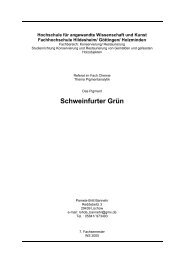Henrik Schulz* and Anita Horn, Archäomertrie-Labor der HAWK ...
Henrik Schulz* and Anita Horn, Archäomertrie-Labor der HAWK ...
Henrik Schulz* and Anita Horn, Archäomertrie-Labor der HAWK ...
Create successful ePaper yourself
Turn your PDF publications into a flip-book with our unique Google optimized e-Paper software.
Manuscript, H. Schulz <strong>and</strong> A. <strong>Horn</strong>, Hildesheim, henrik.schulz@archaeometrielabor.com 15<br />
The estimated contact angles un<strong>der</strong> normal atmosphere (moisten air) are concerned about the<br />
reliability of the measured values onto the untreated as well as the plasma treated wooden<br />
surfaces. Low energy materials tend to adsorb strongly onto high-energy surfaces, as this will<br />
decrease the surface energy of the system. The plasma treatment of wooden surfaces leads to<br />
a bor<strong>der</strong>line case: The surface energy of the solid surface <strong>and</strong> the surface energies of the test<br />
liquids are very similar. The contact angle is small. Contact angles below 10° are poor,<br />
unreliable <strong>and</strong> cause of errors. Therefore we have changed the outer fluid by n-hexane <strong>and</strong><br />
received much better results of the contact angles (see table 4.).<br />
Also the differences in the surface activity of the two kinds of wood before <strong>and</strong> after the<br />
plasma treatment can be realized by staining. The metachromatic shifts ∆λ = λ0 − λ1 of the<br />
adsorbed toluidine blue onto both wood (untreated <strong>and</strong> plasma treated beech <strong>and</strong> spruce) is<br />
given in table 5.<br />
Table 5: The metachromatic shift ∆λ = λ0 − λ1 of untreated (reference) <strong>and</strong> plasma<br />
treated wood samples (means out of 170 spot measurements of the treated<br />
samples <strong>and</strong> 30 spots of the reference for each kind wood), discharge<br />
condition: normal atmosphere of air, pulse duration of 2 µs <strong>and</strong> a pulse<br />
repletion rate of 15 kHz, total time 10 s, duration of staining (imino base<br />
extraction by n-hexane) 10 minutes<br />
wood λ0 [nm] λ1 [nm] ∆λ [nm]<br />
beech 599±1 588±1 11<br />
spruce 591±1 567±1 24<br />
Obviously the increase of the shift ∆λ is accompanied by the decrease of the contact angle Θ .<br />
But there are more hidden details that pointed out the specific adsorption of the dye molecules<br />
onto the activated wooden surface, especially about the role of the number of surface groups<br />
N0 . In the following discussion the energetic aspect of adsorption shall consi<strong>der</strong> in detail.<br />
DISCUSSION<br />
Low-energy materials (organic compounds but also water) tend to adsorb strongly onto highenergy<br />
surfaces <strong>and</strong> decrease the total surface energy of the system. High-energy materials<br />
like metals, metal oxides <strong>and</strong> inorganic compounds (silica, sapphire, graphite) have surface<br />
tensions γS in the range of 200 – 5000 mN/m. On the other h<strong>and</strong>, the or<strong>der</strong> of γS of low-energy


